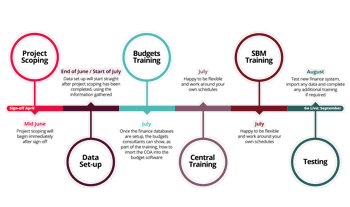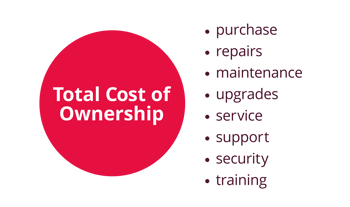 Access Education Finance
Access Education Finance
How to build a business case for school or MAT finance software
To those working in school finance teams, it’s obvious if your systems aren’t coming up to scratch. You regularly come up against issues that either slow tasks down or prevent them being done entirely. Wasting time duplicating information from one spreadsheet to another, or being wedded to long-winded processes just because ‘that’s the way it’s always been done’ needn’t be the norm.
Putting together a business case for school or MAT finance software is much like creating any proposal, it involves gathering support from key stakeholders and evaluating its benefits, costs and risks. A business case may sound intimidating, but it needn’t be which is why we have put this guide together to help you.
Why you need a business case for school or MAT finance software
Those who hold the purse strings within schools – governors or trust members – won’t have witnessed your frustrations at inefficient processes first hand. And at a time when budgets are already under pressure, you need to show these stakeholders that a new system is worth the investment.
It’s down to you to present a convincing business case for school finance software, or really any new software asset a school is looking to adopt – the principles in this guide apply to numerous scenarios. A business case isn’t all about canvassing your colleagues and showing off shiny new technology, it’s an opportunity identify the real-world issues you are facing and demonstrate quantifiable savings that could be made.
As well a financial proposition, a business case is also an educational resource. On paper a “software upgrade” can sound inconsequential to those not in the know, but in real-terms this innocuous ‘upgrade’ could have a hugely beneficial impact on your administrative processes. Centralising operations via the use of cloud based software can save schools hundreds of hours, so it’s certainly worth making sure everybody is aware of the potential savings.
A business case may sound like a huge undertaking, but really this kind of activity takes place every day in schools. Whether using school budgeting software, spreadsheets or even harking back to the faithful old abacus – businesses and organisations have always needed to justify their spend to make sure the books balance. And essentially recording that process formally, is all preparing a business case is.
So let’s look at what things to bear in mind when building a business case for new school finance software.
What to consider when building a business case for your new school or MAT finance software
Identify current difficulties
It’s important to gather some specific examples of the issues you’re experiencing with current processes, and how they affect your school or trust. It could be that some processes are inefficient, waste time or resources, or could cause inaccuracy. Think about administrative-heavy tasks like processing orders, payroll reconciliation, budget monitoring, producing reports and completing VAT returns – many aspects of these processes can be automated using software, so spend some time identifying pain points and get everybody in the office to record them and see what issues come up most regularly.
Think about efficiency
Financial transparency is a huge issue for many schools and MATs, and adds hours into the working week if finance teams struggle to get a complete, accurate view of their finances . Ease of reporting (internally and externally) is one of the most commonly cited benefits of a school-specific finance system. List the various bodies you currently provide information to and point out the areas where reporting is impossible. For the rest, highlight where you’re forced to make assumptions due to the data issues you face.
Time itself is also a valuable commodity for most schools and trusts, especially if you’re short of operational staff. For the examples you came up with for the point above, calculate the time you’re wasting due to inefficient processes. How would that time increase if more members of staff join your school or trust? How could it be put to better use?
Examine your exposure to risk
Are your current systems compliant with current regulation, or are they leaving your school or trust exposed to risk? Think about how secure your documents and data are, and consider what would happen if you experienced:
- A malicious threat from a third party
- An internal threat from a member of staff
- An inadvertent data breach, such as a misaddressed email containing employee data, or a physical file being lost
- Accidental loss or destruction of data held on site
- Uncertainty around schemes of delegation and approval workflows
Next, it’s a good idea to identify any risk areas, work out the level of risk based on your current processes, and highlight the problem areas that could be addressed with a new system.
Consider your costs
Showing that a new system would save money – which can then be re-invested in education – is a sure-fire way to get governors’ or the SLT’ attention. Financially oriented decision-makers are interested in three core areas:
- What’s the cost of doing nothing?
- What savings could be made?
- What new costs will be incurred?
The first of these gives you the opportunity to identify the value of the time and resources currently being wasted. Refer back to the inefficiencies you identified earlier and give them monetary values based on an hourly rate and the amount of time spent. Show how much it would cost each month if you continue just as you are.
Next, define the time savings and corresponding monetary value with a new, more efficient finance system in place. Think about the key functions that can be automated and assign costs to one-off tasks such as responding to data access requests or creating a management report.
Thirdly, give a summary of the investment needed to support the proposed new system, including up-front and ongoing costs. Think about how it’s priced, whether there’s a flexible payments option, whether upgrades are included, whether there are any additional costs and when schools typically see a return on investment.
Discover reliable software to confidently manage your school finances
How to actually build a business case for school or MAT finance software
It’s important to present the full scope of your business case to the senior leadership team or other decision making stakeholders, so it’s clear that you’ve considered the full impact of your proposal and there is an opportunity for feedback and discussion. This open dialogue is especially important when asking for the amount of money the new software will require as well as possible ongoing maintenance costs.
Describe your solution
It’s recommended that you describe your solution with as much detail as possible to answer any questions stakeholders may have. You should be able to find out details about the proposed software via any providers you are gathering quotes from, they should be happy to help you build your business case.
When building out a description of your software, it’s worth listing all the features in the style of a specification so no detail is lost. Some suggested headers you may want to cover in the business case are as follows:
- Technical specification
- Administration specification
- Statutory/Legal compliance
- Cashless catering systems
- Chart of accounts
- Accounts payable
- Accounts receivable
- Budget management
- General ledger
- Petty cash
- Payroll
- Linking to third party products
- Communication
- Reporting
- Document management
- Non-functional requirements
Details covered by each header will differ depending on which software you’re looking at and what the solution integrates with, its technical features etc. You can usually find a detailed specification in any sort of quote document provided by the prospective supplier so you can use this as the basis for describing your solution within the business case.
Describe the cost overview
Most salespeople will be able to provide you with a detailed breakdown of what your software investment will provide for your school or MAT. It is worth outlining the total cost of the software, how this is paid along with any additional factors that need to be considered. Is everything payable up front? Are the costs spread out over the term of your contract? What are the payment terms? Also make sure that any maintenance costs or fees are clearly stated so there are no surprises at any point during the contract. What you get for your money should be outlined in a service level agreement (SLA).
Depending on your needs and budget, companies can offer differing levels of service which covers things like technical support, response times, business hours etc. It’s worth investigating and thoroughly discussing all the options available to you as these will have an impact on the total cost.
Describe the benefits of the software
The key to any school finance software being successful is the ability for it to save your school or MAT time, and money. The key to this is looking at the features of the software and breaking down what this actually means for your school or trust finance team. For example, what does being cloud based actually bring to your team? The software can be accessed at any time from anywhere, meaning no downtime with staff waiting hours to access their work from home or elsewhere – meaning no business hours lost.
A reporting suite sounds great, but what benefits will this actually bring to your team? High level insights such as these can help you spot overspend well in advance of it happening, giving your team time to mitigate any problems and save money well before crunch time.
Benefits like this are the real selling point of any potential investment, so it’s really important that you make them bespoke to your school to maximise the chances of the business case being a success. It can be useful to ask your software provider for references or customer case studies which can illustrate the benefits software has had on schools.
Describe the timeline of implementing the software
Continuing on the theme of time, it’s important to illustrate to stakeholders just how long the software will take to roll-out and the time it takes to go-live.
Depending on your school’s or MAT’s set up, implementation can look different to everyone. Below is an example timeline which thoroughly outlines each step of the process from project scoping to product testing, including data set-up and staff training.

Showing this process as an illustration can be a useful way of communicating to all stakeholders and managing expectations amongst those directly affected by the implementation. It may even be worth printing this out and sticking it up on a wall where everyone can see it at the start of the project and keep checking in to see what the project status is, or presenting it at regular steering group meetings.
Describe the project governance
Project governance will be a shared responsibility between the school and company providing your school finance software. When building the business case its important to define the framework by which decisions are made. Project governance covers any:
- Policies
- Regulations
- Functions
- Processes
- Procedures
- Responsibilities
These factors can be considered in terms of structure, people and information. For more detail on project governance, look at this site. It’s a good idea to keep projects on track by proposing regular steering committee meetings and catch ups with your project or account manager within the organisation you are conducting business with.
How to calculate total cost of ownership
As mentioned previously in the article, the purchase cost of any software is usually only part of the overall investment. In terms of the implementation, its worth thinking about how many hours the team are going to need out of the organisation undertaking training and what the financial impact of that will be.

Additionally, check the terms and conditions to see if extras like training, data migration or other things required to implement the software are included in the overall cost or will it be extra. For transparency, make sure all this is covered in the business case. It may seem like a big ask, but it’s better to be up front about all costs than encounter any nasty surprises that may be difficult to justify budget for further down the line.
How to calculate return on investment (ROI)
Calculating return on investment is different for any organisation, school or MAT and wildly depends on the sort of software, package type, length of contract term etc. As a general rule of thumb, ROI can be calculated as:

It can be difficult to quantify exactly what the “gains from investment” are in any business, let alone the education sector as there are so many variables affecting this figure such as staff efficiency, wage bill, manual processes etc.
Software providers can try to assess your current ways of working and see where software can help save you money. If needs be, if it helps to invite a sales representative or account manager into the school to discuss this with your staff that can be a helpful activity which contributes towards building the business case.
How to get stakeholder support for your school or MAT finance software business case
As above, it can be helpful to invite representatives from software companies into your school to meet with your finance staff, senior leadership team and key decision makers. It’s not just a company’s responsibility to sell software, they must also help illustrate the benefits and talk about any sort of after-care or support which is provided throughout the contract. If decision makers establish a relationship with the software provider, paired with a solid business case, it’s likely to increase the rate of success.
Nominating somebody internally as the project lead who is responsible for answering any questions and concerns during the scoping phase can help reassure stakeholders and ensure vital questions are answered before the business case is decided upon. Make sure those responsible for releasing funds or approving key documents should also be kept in the loop even if the software doesn’t directly affect their day-to-day responsibilities.
Ultimately, transparency and visibility are key factors in gaining support for any school finance software business case so do whatever you can to make sure your proposal meets this criteria.
What to do if your school finance software business case is rejected
If the business case is rejected, don’t despair.
It’s actually quite rare for this to happen because if the proposal is put together pursuant to the tips in this guide, any proposed software won’t be wildly out of scope. It is assumed that when putting together a document such as this, stakeholders have already consulted closely with software providers and already have a rough idea of the costs, savings and benefits such a software can bring to an MAT or school. Therefore, there shouldn’t be any nasty surprises once this information is formalised in a business case.
Things can of course slip through the net and no business case is perfect. A school’s needs can change suddenly and staff turnover can all contribute towards a disappointing outcome. If this does happen, use it as an opportunity to regroup – meet internally with any stakeholders involved in the decision making process to assess why the bid has been rejected. Often it can just be that a minor tweak is required or that somebody has missed a minor detail.
If there is a larger issue at play, don’t hesitate to engage with your software provider – perhaps they can give further demonstrations or hold conversations with decision makers to increase the chances of buy-in. Also don’t be afraid to negotiate, salespeople are used to some pushback from customers on timelines and costs – it may not always be possible, but companies that want your business will do their best to guarantee success and work with you to get the project across the line.
What next
Need more support putting together your business case? We have a number of helpful guides that can support your school’s investment in new software.
Choosing the right financial software can help if you’re at the beginning of your purchasing journey, while our building a business case for a school financial management system provides supplementary information that hasn’t been covered in this guide.
Of course you can also contact our team of education experts for any questions you may have on school finance software.

 AU & NZ
AU & NZ
 SG
SG
 MY
MY
 US
US
 IE
IE

